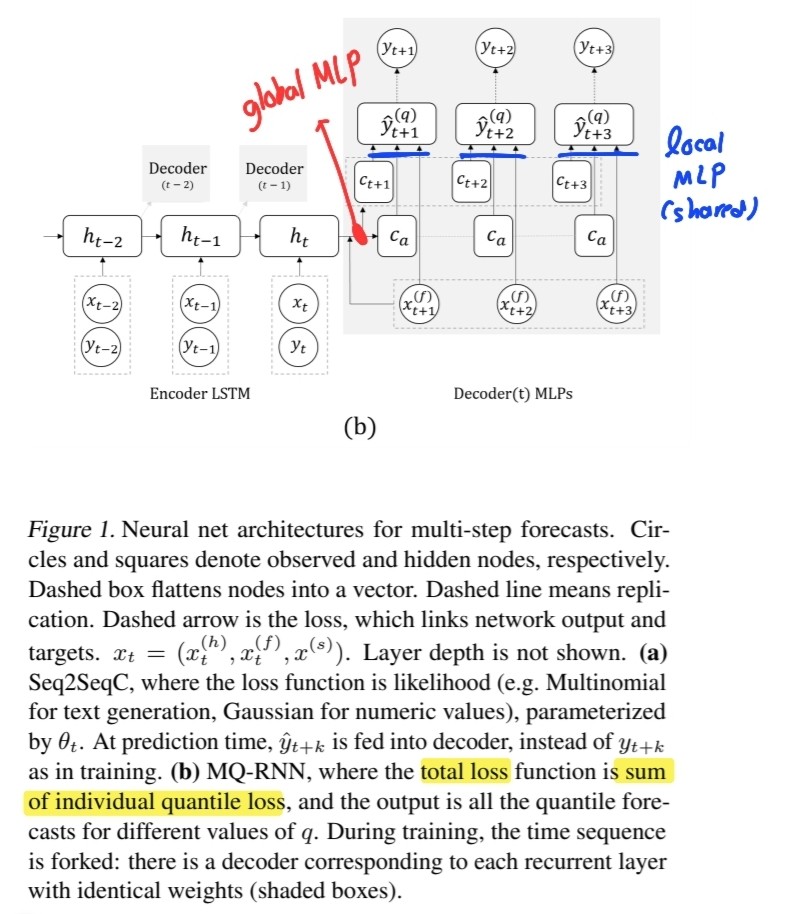A Transformer-based A Multi-Horizon Quantile Recurrent Forecaster (2017, 137)
Contents
- Abstract
- Introduction
- Related Works
- Methodology
- loss function
-
architecture
-
training method
- encoder extension
- practical consideration
0. Abstract
Probabilistic Multi-step TS regression
- key 1) seq2seq
- key 2) Quantile Regression
- new training scheme : forking-seqeuences
- Multivariate
- use both “temporal & static” covariates
Test on
- 1) Amazon.com
- 2) electricity price and load
1. Introduction
Goal :
- predict \(y_{t+1}\)
- given \(y_{: t}=\left(y_{t}, \cdots, y_{0}\right)\)
Many related time-series are present!
- ex 1) dynamic historical features
- ex 2) static attributes
most of models are built on “one-step-ahead” approach
-
estimate \(\hat{y}_{t+1}\), given \(y_{: t}\)
-
called Recursive Strategy
( = Iterative = Read-outs )
-
problem : error accumulation
Direct strategy
- direclty predicts \(y_{t+k}\) given \(y_{: t}\)
- less biased / more stable / more robust
- Multi-horizon strategy
- predict \(\left(y_{t+1}, \cdots, y_{t+k}\right)\)
- avoid error accumulation
- retains efficiency by sharing parameters
Probabilistic Forecast
-
\(p\left(y_{t+k} \mid y_{: t}\right)\).
-
traditionally achieved by assuming an error distribution ( or stochastic process )
( Gaussian, on the residual series \(\epsilon_{t}=y_{t}-\hat{y}_{t}\). )
-
Quantile Regression
- predict conditional quantiles \(y_{t+k}^{(q)} \mid y_{: t}\)
- \(\mathbb{P}\left(y_{t+k} \leq y_{t+k}^{(q)} \mid y_{: t}\right)=q\).
- robust ( \(\because\) no distributional assumptions )
MQ-R(C)NN
- seq2seq framework
- generate Multi-horizion Quantile forecasts
- \(p\left(y_{t+k, i}, \cdots, y_{t+1, i} \mid y_{: t, i}, x_{: t, i}^{(h)}, x_{t:, i}^{(f)}, x_{i}^{(s)}\right)\).
- \(y_{\cdot, i}\) : \(i\) th target TS
- 1) \(x_{: t, i}^{(h)}\) : temporal covariates ( available in history )
- 2) \(x_{t:, i}^{(f)}\) : knowledge about the future
- 3) \(x_{i}^{(s)}\) : static, time-invariant features
-
each series : considered as one sample
( fed into single RNN / CNN )
- enables cross-series learning, cold-start forecasting
First work to combine RNNs & 1d-CNNs with QR or Multi-horizon forecasts
2. Related Work
[1] RNNs & CNNs
- point forecasting
[2] Cinar et al (2017)
-
attention model for seq2seq
on both UNIVARIATE & MULTIVARIATE ts
-
but, built on Recusrive Strategy
[3] Taieb and Atiya (2016)
- multi-step strategies on MLP
- Direct Multi-horizon strategy
[4] DeepAR (2017)
- probabilistic forecasting
- outputs “parameters of Negative Binomial”
- trained by maximizing likelihood & Teacher Forcing
[5] MQ-R(C)NN
- more practical than relevant Multi-horizon strategy
- more efficient training strategy
3. Method
-
loss function
-
architecture
-
training method
- encoder extension
- practical consideration
(1) loss function
Quantile Loss :
- \(L_{q}(y, \hat{y})=q(y-\hat{y})_{+}+(1-q)(\hat{y}-y)_{+}\).
- \((\cdot)_{+}=\max (0, \cdot)\).
- when \(q=0.5\) : just MAE
- \(K\) : # of horizons of forecasts
- \(Q\) : # of quantiles of interest
\(\hat{\mathbf{Y}}=\left[\hat{y}_{t+k}^{(q)}\right]_{k, q}\) :
- \(K \times Q\) matrix
- output of of parametric model \(g\left(y_{: t}, x, \theta\right)\)
Total Loss : \(\sum_{t} \sum_{q} \sum_{k} L_{q}\left(y_{t+k}, \hat{y}_{t+k}^{(q)}\right)\)
(2) architecture
- base : RNN seq2seq
- encoder : LSTM
- (recursive) deocder :2 MLP branches
- 1) (global) MLP
- 2) (local) MLP
1) (global) MLP
- \(\left(c_{t+1}, \cdots, c_{t+K}, c_{a}\right)=m_{G}\left(h_{t}, x_{t:}^{(f)}\right)\).
- input : “encoder output” & “future inputs”
- output : 2 contexts
- # 1) horizon-specific context : \(c_{t+k}\) ( for each \(K\) future points )
- # 2) horizon-agnostic context : \(c_a\)
2) (local) MLP
-
\(\left(\hat{y}_{t+k}^{\left(q_{1}\right)}, \cdots, \hat{y}_{t+k}^{\left(q_{Q}\right)}\right)=m_{L}\left(c_{t+k}, c_{a}, x_{t+k}^{(f)}\right)\).
-
applies to each specific horizon
- parameters are shared across all horizons \(k \in\{1, \cdots, K\}\)
- generate sharp & spiky forecats
- tempting to use LSTM, but unnecessary & expensive!

(3) training method
Forking-sequences training scheme
- endpoint
- where ENC & DEC exchange
- also called FCT(Forecast Creation Time)
- time step where future horizons must be generated
- mathematical expression
- 1) encoder : LSTM
- \(\forall t, h_{t}=\operatorname{encoder}\left(x_{: t}, y_{: t}\right)\).
- 2) decoder : global/local MLPs
- \(\hat{y}_{t:}^{(q)}=\operatorname{decoder}\left(h_{t}, x_{t:}^{(f)}\right)\).
- 1) encoder : LSTM
Direct strategy :
- criticized as not being able to use data between \(T-K\) & \(T\)
- thus, mask all the error terms after that point
(4) encoder extension
many forecasting problems have long periodicity ( e.g 365 days)
& suffer from memory loss
NARX RNN
-
compute hidden state \(h_t\),
-
not only based on \(h_{t-1}\)
-
but also \((h_{t-2},...h_{t-D})\)
( = skip connection )
-
-
put an extra linear layer on top of LSTM to summarize them
- \(\tilde{h}_{t}=m\left(h_{t}, \cdots, h_{t-D}\right)\).
Lag-seires LSTM
- feed past series as lagged feature inputs
- \(\left(y_{t-1}, \cdots, y_{t-D}\right)\).
WaveNet
- not restricted to RNN
- WaveNet : stack of dilated causal 1d-Conv

(5) future & static features
[1] Future Features
- [1-1] seasonal features
- [1-2] event features
[2] Static Features
